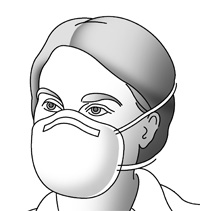
Respiratory Infection Control: Respirators Versus Surgical Masks It is important that employers and workers understand the significant differences between these two types of personal protective equipment. The decision whether or not to require workers to use either surgical masks or respirators must be based upon a hazard analysis of the workers' specific work environments and the different protective properties of each type of personal protective equipment. The use of surgical masks or respirators is one practice that may reduce the risk of fox13.infectious disease transmission between infected and noninfected persons. Since there is limited historical information on the effectiveness of surgical masks and respirators for the control of influenza during any previous pandemics, the effectiveness of surgical masks and respirators has been inferred on the basis of the mode of influenza transmission, particle size and professional judgment. To offer protection, both surgical mask and respirators need to be worn correctly and consistently. If used properly, surgical masks and respirators both have a role in preventing different types of exposures. During an influenza pandemic, surgical masks and respirators need to be used in conjunction with interventions that are known to prevent the spread of infection, such as engineering and administrative controls (e.g., installing sneeze guards, teleworking) and work practices (e.g., cough etiquette, hand hygiene, and avoiding large gatherings). Respirators Respirators are designed to reduce a worker's exposure to airborne contaminants. Respirators come in various sizes and must be individually selected to fit the wearer's face and to provide a tight seal. A proper seal between the user's face and the respirator forces inhaled air to be pulled through the respirator's filter material and not through gaps between the face and respirator.
Where workers are required by employers to wear respirators, they must be NIOSH-certified, selected, and used in the context of a comprehensive respiratory protection program, (see OSHA standard 29 CFR 1910.134, or www.osha.gov/SLTC/respiratoryprotection/index.html). It is important to medically evaluate workers to ensure that they can perform work tasks while wearing a respirator. For many workers, medical evaluation may be accomplished by having a physician or other licensed healthcare provider review a worker (found in Appendix C of OSHA's Respiratory Protection standard, 29 CFR 1910.134) to determine if the worker can be medically cleared to use a respirator. Employers who have never before needed to consider a respiratory protection plan should note that it can take time to choose an appropriate respirator to provide to workers; arrange for a qualified trainer; and provide training, fit testing and medical evaluation for their workers. If employers wait until an influenza pandemic occurs, they may be unable to implement an adequate respiratory protection program in a timely manner. Surgical Masks Surgical masks are used as a physical barrier to protect the user from hazards, such as splashes of large droplets of blood or body fluids. Surgical masks also protect other people against infection from the person wearing the surgical mask. Such masks trap large particles of body fluids that may contain bacteria or viruses expelled by the wearer. Surgical masks are used for several different purposes, including the following:
Surgical masks are not designed or certified to prevent the inhalation of small airborne contaminants. These particles are not visible to the naked eye but may still be capable of causing infection. Surgical masks are not designed to seal tightly against the user's face. During inhalation, much of the potentially contaminated air can pass through gaps between the face and the surgical mask and not be pulled through the filter material of the mask. Their ability to filter small particles varies significantly based upon the type of material used to make the surgical mask, so they cannot be relied upon to protect workers against airborne infectious agents. Only surgical masks that are cleared by the U.S. Food and Drug Administration to be legally marketed in the United States have been tested for their ability to resist blood and body fluids. This is one in a series of informational fact sheets highlighting OSHA programs, policies or standards. It does not impose any new compliance requirements. For a comprehensive list of compliance requirements of OSHA standards or regulations, refer to Title 29 of the Code of Federal Regulations. This information will be made available to sensory impaired individuals upon request. The voice phone is (202) 693-1999; teletypewriter (TTY) number: (877) 889-5627. For more complete information:
www.osha.gov (800) 321-OSHA DSG 5/2009 |

 Respirators offer the best protection for workers who must work closely (either in contact with or within 6 feet) with people who have influenza-like symptoms. These generally include those workers who work in occupations classified as very high exposure risk or high exposure risk to pandemic influenza. For additional information on very high and high exposure risk occupations, please refer to OSHA Publication No. 3327, entitled Guidance on Preparing Workplaces for an Influenza Pandemic, which can be found at
Respirators offer the best protection for workers who must work closely (either in contact with or within 6 feet) with people who have influenza-like symptoms. These generally include those workers who work in occupations classified as very high exposure risk or high exposure risk to pandemic influenza. For additional information on very high and high exposure risk occupations, please refer to OSHA Publication No. 3327, entitled Guidance on Preparing Workplaces for an Influenza Pandemic, which can be found at 